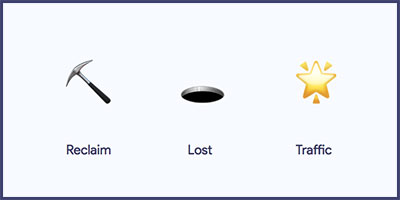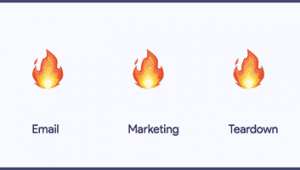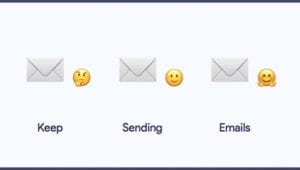How to Get Found on Google and Grow Your Site Traffic With Search Console Data
⛏
Reclaim
?️
Lost
?
Traffic
Everyone wants more traffic.
More traffic means more prospects, more sales, more impressions, and a faster feedback loop.
Now, it’s easy to look at your site and the content you’ve already published thinking they’re performing as well as they could, but… that’s rarely the case.
There’s almost alway ways to…
- Increase the amount of traffic your best pages are getting;
- Make your pages more attractive to convince people to pick your listing on Google;
- Reposition an old post to attract a new pool of readers.
But this all starts with data. The right kind of data.
In this post, we’ll show you how to get found on Google to get more (free) organic traffic with the Search Console and Highlights.
Let’s do this! ?
Why Care About the Search Console?
What if I told you that you’re sitting on useful data you’re likely under-utilizing? ?
I know, I know… it feels too good to be true…
I hate to admit it, but for the longest time, I used to think that the Google Search Console – ex-Webmaster Tools – was simply a place to upload sitemaps and get indexation alerts. I didn’t think it could be used to proactively increase your search traffic.
Turns out that the GSC gives you access to backlinks, internal link structures, search intent keywords, clickthrough rates, and a ton more useful data to improve your search rankings.
You can use GSC data to optimize your existing content, or create brand new content. That said, no matter what you do, you need a good setup.
Getting Started with the Google Search Console
To get started with the Google Search Console, login and click on ‘+ Add Property’ from the top-left menu:

Enter the main URL of your site (typically starting with https://…):

You’ll be asked to validate ownership of the domain. This can be done by adding a meta tag in the header of your homepage, uploading a shell HTML file, using Google Analytics data, and a few other ways. Pick the easiest, and keep going.
(Note: if you’ve already set up your Search Console account. Good news! You might have up to 16 months of search data to play with AND can now skip to the next section?)
This past year, Google has been transitioning features from the old Google Search Console to the new GSC. Although it’s not an essential step, you can access the old Google Search Console to set a ‘Preferred Domain’ for your site. The preferred domain format you choose determines how Google displays your links in search results:

Next, add a sitemap to help Google know what pages matter most on your site.
If your website was built on WordPress, you can create an XML sitemap using the Yoast plugin. Once you do, your sitemap will look a bit like this one.
Copy your sitemap URL, and add it under ‘Sitemaps’:

It can take up to 2 days for Google to retrieve your search data, but once they do, you’ll have access to funky charts like this one:

You can connect Google Search Console to your Google Analytics account to be able to access search keywords in Google Analytics (GA). This can be done from the ‘Search Console Settings’ section (Admin > Property Settings > Adjust Search Console > Add):

Once the tools are connected, search keywords will be displayed under ‘Queries’ (Acquisition > Search Console > Queries).
Search queries are a key report for any bloggers seeking more search traffic.
How to Get Found on Google Using the Google Search Console
There are hundreds of ways to use Search Console data to grow your site traffic. However, for this post, we’ll focus on how to get found on Google in 3 ways:
- Strengthening the keywords your pages already rank for;
- Improving the clickthrough rates of your pages in search rankings;
- Repositioning pages with little to no organic traffic to address better keyword opportunities.
In GSC, you’ll find most of the interesting data under ‘Performance’.
From this report, you’ll be able to see Impressions (the number of times your page were shown in search results), Clicks (the number of times your listings got clicked), CTR (the percentage between both metrics), and Average Position (the usual ranking for your listings).
Finding the Keywords Driving Traffic to Your Pages
From the ‘Performance’ report, you can find any page’s keywords by clicking ‘+ New’ at the top of the page, selecting ‘Page’ and entering the full URL of your page:

Search Console will retrieve the list of keywords that led visitors to your page. For each keyword, you’ll get search volume and click data:

Do any of the keywords listed surprise you?
- IF yes, let’s keep going. ?
- IF no, you can solidify your position in the rankings by further clarifying the topic of your page. You can also add secondary keywords to reinforce your ranking.
Finding Pages With Low Clickthrough Rates
Clickthrough rates (CTRs) – the percentage of time your listing gets clicked in search results – are a key Google ranking factor.
In general, improving your page’s attractiveness in search results improves your search ranking.
To add CTR data to the report, highlight ‘Average CTR’:

To focus on keywords with low clickthrough rates, filter the results by clicking the funnel / downward arrow:

Sort the data by the number of impressions. Are there important / high-traffic keywords with low CTRs?
There are 3 things you can experiment with to improve a keyword’s CTR and get more clicks:
- Page Title;
- Display URL;
- Meta Description.

Beware of breaking the performance of your other keywords when making changes.
Note: Below, we’ll show you an even better way to optimize CTRs.
Uncovering the ‘Other’ Keywords Your Page Ranks for
Google is mysterious. ? Chances are that your pages both rank for keywords you wanted to rank on ?, and keywords you didn’t expect to rank on. ?
For example, our post ‘Everything Wrong With Analytics Dashboards (And Our Plan to Fix It)‘ ranks for the keyword ‘Everything Wrong With’, which is not quite what we were trying to do…
Happy surprise? Maybe.
To uncover the other keywords your pages rank for, remove the page filter, add ‘Average Position’, and set the date range to the last 28 days:

Now, sort by ‘Impressions’:

Are there keywords with large amounts of traffic?
You’re dealing with a big opportunity when a keyword manages to get 22k impressions on the 5th page (Position 55.9!)… Click on the specific keyword, and switch over to ‘Pages’:

Now this tells me that if I manage to reposition this page for the keyword ‘business problem’ (generic!), I’ll drive a huge amount of traffic to my site.
This can be done by:
- Changing the page keywords;
- Adding a lot of in-depth content on the topic to the page;
- Getting more backlinks;
- Adding more internal links pointing to this page with the appropriate keywords.
It’s hard work, but it may be worth the effort! ?
How to Get Found on Google with Highlights’ New Search Console Integration
At Highlights, we’re always looking for ways to make existing data more useful.
Not only does Highlights analyzes organic search traffic, it now analyzes search keyword performance using target clickthrough rates by Advanced Web Ranking.
Highlights assesses search keywords and puts them in 3 categories:
1. Top Keywords

Top keywords are the keywords your page has a solid grip on.
You can use this report to create pillar pages, and strengthen your search rankings.
You can also use it to reinforce secondary keywords.
2. Underperforming Keywords

Underperforming keywords are the search queries that list your page, but don’t generate sufficient clicks and visits.
You might be getting traffic from these keywords, but based on your content, you have the potential to get more.
Unless an Underperforming keyword has massive search volume, you shouldn’t jeopardize the performance of your Top Keywords to try and include underperformers in your page content.
For these keywords, Highlights gives you the Target CTR based on Advanced Web Ranking data. Again, you can improve your CTR by optimizing your page titles and descriptions.
3. Keyword Opportunities

The ‘Opportunities’ report lists keywords Google thinks your page can be a good fit for, but that don’t result into clicks.
This information can be really useful when your page is not getting a lot of search traffic, and high-traffic keywords are available. Since the data comes directly from Google, it’s easier to tell whether or not investing time repositioning your page is worth it.
How to Get Found on Google with Highlights
At Highlights, we believe in continuous optimization – it’s why we’re building Highlights in the first place!
Our new Search Console integration will show you how to get found on Google, and Highlights will help continuously grow your conversions and traffic.
The right way to get results with your inbound program is to make continuous improvements. So, let’s get to it! ?





Leave a Reply
Want to join the discussion?Feel free to contribute!